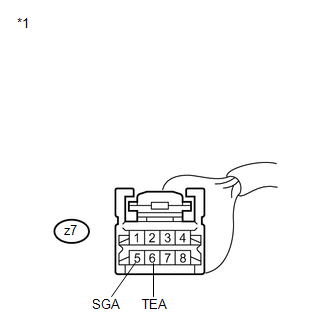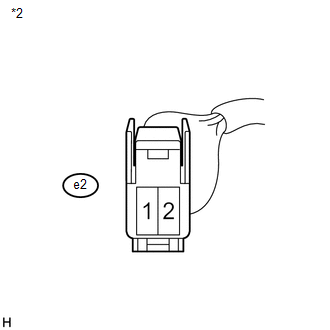Toyota Venza: Evaporator Temperature Sensor Circuit (B1413/13)
DESCRIPTION
The evaporator temperature sensor is installed on the evaporator in the air conditioning unit to detect the cooled air temperature that has passed through the evaporator and to control the air conditioning. It sends appropriate signals to the A/C amplifier. The resistance of the evaporator temperature sensor changes in accordance with the cooled air temperature that has passed through the evaporator. As the temperature decreases, the resistance increases. As the temperature increases, the resistance decreases.
The A/C amplifier applies voltage (5 V) to the evaporator temperature sensor and reads voltage changes as the resistance of the evaporator temperature sensor changes. This sensor is used for frost prevention.
|
DTC No. |
DTC Detection Condition |
Trouble Area |
|---|---|---|
|
B1413/13 |
Open or short in evaporator temperature sensor circuit |
|
WIRING DIAGRAM
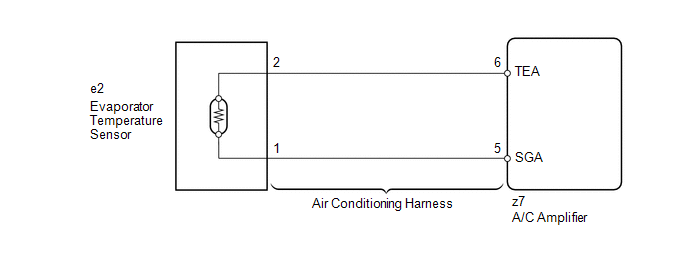
PROCEDURE
|
1. |
READ VALUE USING TECHSTREAM |
(a) Connect the Techstream to the DLC3.
(b) Turn the ignition switch to ON.
(c) Turn the Techstream on.
(d) Enter the following menus: Body / Air Conditioner / Data List.
(e) Check the value(s) by referring to the table below.
Air Conditioner|
Tester Display |
Measurement Item/Range |
Normal Condition |
Diagnostic Note |
|---|---|---|---|
|
Evaporator Fin Thermistor |
Evaporator temperature sensor / Min.: -30°C (-22°F) Max.: 59.6°C (139.28°F) |
Actual evaporator temperature displayed |
- |
OK:
The display is as specified in the Normal Condition column.
|
Result |
Proceed to |
|---|---|
|
NG |
A |
|
OK (When troubleshooting according to Problem Symptoms Table) |
B |
|
OK (When troubleshooting according to the DTC) |
C |
| B | .gif) |
PROCEED TO NEXT SUSPECTED AREA SHOWN IN PROBLEM SYMPTOMS TABLE |
| C | .gif) |
REPLACE A/C AMPLIFIER |
|
|
2. |
INSPECT EVAPORATOR TEMPERATURE SENSOR |
(a) Remove the evaporator temperature sensor.
(b) Disconnect the evaporator temperature sensor connector.
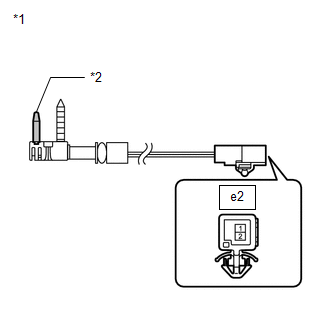
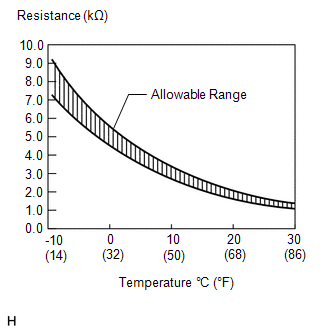
(c) Measure the resistance according to the value(s) in the table below.
Standard Resistance:
|
Tester Connection |
Condition |
Specified Condition |
|---|---|---|
|
e2-1 - e2-2 |
-10°C (14°F) |
7.30 to 9.10 kΩ |
|
e2-1 - e2-2 |
-5°C (23°F) |
5.65 to 6.95 kΩ |
|
e2-1 - e2-2 |
0°C (32°F) |
4.40 to 5.35 kΩ |
|
e2-1 - e2-2 |
5°C (41°F) |
3.40 to 4.15 kΩ |
|
e2-1 - e2-2 |
10°C (50°F) |
2.70 to 3.25 kΩ |
|
e2-1 - e2-2 |
15°C (59°F) |
2.14 to 2.58 kΩ |
|
e2-1 - e2-2 |
20°C (68°F) |
1.71 to 2.05 kΩ |
|
e2-1 - e2-2 |
25°C (77°F) |
1.38 to 1.64 kΩ |
|
e2-1 - e2-2 |
30°C (86°F) |
1.11 to 1.32 kΩ |
NOTICE:
- Hold the sensor only by its connector. Touching the sensor may change the resistance value.
- When measuring, the sensor temperature must be the same as the ambient temperature.
HINT:
As the temperature increases, the resistance decreases (see the graph).
Text in Illustration|
*1 |
Component without harness connected (Evaporator Temperature Sensor) |
|
*2 |
Sensing Portion |
| NG | .gif) |
REPLACE EVAPORATOR TEMPERATURE SENSOR |
|
|
3. |
INSPECT AIR CONDITIONING HARNESS (A/C AMPLIFIER - EVAPORATOR TEMPERATURE SENSOR) |
|
(a) Remove the air conditioning harness. |
|
|
(b) Measure the resistance according to the value(s) in the table below. Standard Resistance:
|
|
| OK | .gif) |
REPLACE A/C AMPLIFIER |
| NG | .gif) |
REPLACE AIR CONDITIONING HARNESS |
 Pressure Sensor Circuit (B1423/23)
Pressure Sensor Circuit (B1423/23)
DESCRIPTION
This DTC is output when refrigerant pressure on the high pressure side is extremely
low (190 kPa (1.9 kgf/cm2, 28 psi) or less) or extremely high (3140 kPa (32.0 kgf/cm2,
455 psi) or ...
 Compressor Lock Sensor Circuit (B1422/22)
Compressor Lock Sensor Circuit (B1422/22)
SYSTEM DESCRIPTION
The ECM sends the engine speed signal to the A/C amplifier via CAN communication.
The A/C amplifier reads the difference between compressor speed and engine speed.
When the diff ...
Other materials about Toyota Venza:
Intake Manifold Runner Position Sensor / Switch Circuit (Bank 1) (P2014,P2016,P2017)
DESCRIPTION
The tumble control valve position sensor is a non-contact type sensor.
The position sensor measures the opening angle of the tumble control valve. The
sensor is reliable and accurate, as it is electrically controlled by Hall elements.
...
No Sound can be Heard from Speakers
PROCEDURE
1.
CHECK AUDIO SETTINGS
(a) In sound output setting mode, set volume, fader and balance to the initial
values and check that the sound is normal.
OK:
Audio system returns to normal.
HINT:
Sound quality adjustm ...
Removal
REMOVAL
PROCEDURE
1. DISCONNECT CABLE FROM NEGATIVE BATTERY TERMINAL
NOTICE:
When disconnecting the cable, some systems need to be initialized after the cable
is reconnected (See page ).
2. REMOVE NO. 1 ENGINE COVER SUB-ASSEMBLY
3. REMOVE COOL AIR ...
0.1599

.gif)
